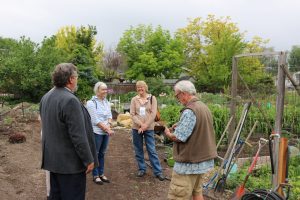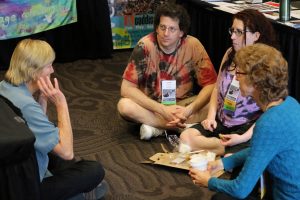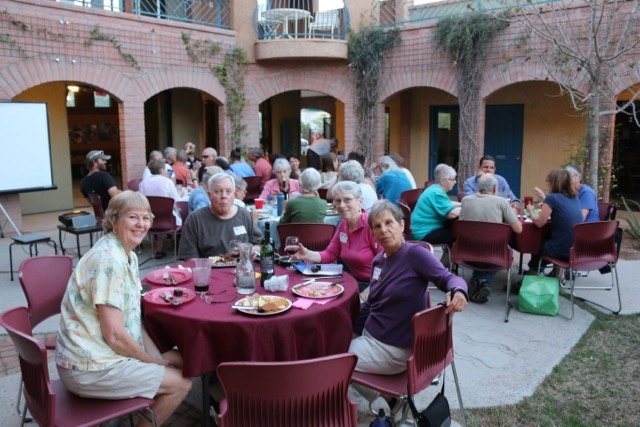Sustainable
Is Cohousing The Best Solution To Aging Well?
By
Filed under: Meaningful, Rightsized, Sustainable
Cohousing isn’t a new concept. In fact, humans have been coming together in community for thousands of years to survive and thrive. What is new is that these days many of us have grown so independent and disconnected that we’ve forgotten why community is important in the first place. Maybe when we are young, busy, and focused on the needs of one’s immediate family, that isn’t so important. But eventually, if people begin to value experiences, relationships, and good health more than the stuff they accumulate and the accolades they obtain as they age, things start changing. That’s when being a part of a strong and vibrant community starts sounding more and more appealing. It’s also when the idea of cohousing may pop up as a solution. Is it a key to helping people age better? Those who have embraced it say, “Yes!”
During a 2016 conference titled, “Cohousing: Aging Better Together”, architect Charles (Chuck) Durrett admitted that with cohousing, “We aren’t doing anything that hasn’t been done before, but now we are doing it consciously.” He and his wife Kathryn (Katie) McCamant coined the word “cohousing” and pioneered the movement here in the United States after visiting Denmark in the 1980s. The design and overwhelming benefits of the lifestyle so intrigued them that together they have gone on to help create over 50 cohousing communities here in the U.S.
According to Durrett, the key to cohousing is the design. Unlike the traditional “consumer model of housing” where a person shops around trying to find a home and a good neighborhood, cohousing takes a more proactive approach by putting the neighborhood and community first. And how do you do that? As Durrett says, “It’s cohousing math. 1 + 1 =3.” In other words, when people come together consciously to design a neighborhood the way they would really like it to be, what they end up creating is a community that fits their needs in multiple ways. The camaraderie, the memories, the shared decisions, all add up to shared history and connection. As Durrett said, “Proximity is an ally to the process and effort is connected to happiness.”
The two-day Conference, held in Salt Lake City in May 2016, hosted over 250 attendees and featured Chuck Durrett, Katie McCamant and a dozen others who either construct, design, currently live in, or those who hope-to-live-in a cohousing community. While most existing cohousing communities are multi-generational (meaning they allow children and all age groups), the new trend appears to be senior cohousing. As Eric Cress from Urban Development Partners (UDP) said about the vertical model of cohousing his company is building in Portland, OR, “This generation of seniors is not going to conform to prior aging models.” Cress is excited about the possibilities of cohousing and continued with, “This is the time for developers like us to influence how people age in a vibrant way.”

What every speaker at the conference seemed to agree on was that cohousing brings people together. And when people come together, they thrive—especially as they age. Is it challenging to live so closely and interdependently as the cohousing model? Yes, it can be. But as one person said, “Yesterday I was playing bridge, today I’m creating a neighborhood.” Not only does cohousing communities work together to create a neighborhood that satisfies them all on a deep level, but the very act of working together in proximity adds to their connections. As Durrett says, “Cooperation is really the windfall and ultimately trumps the architecture.” The creation of a cohousing community allows each member to get in touch with what is most important to them, what they really want in a home and a neighborhood. That, in turn, gets them in touch with what they want to “be” in the future. That valuable awareness is important no matter what a person’s age, but it is particularly important as a senior.
A big part of the design in every cohousing community is the Common House. While each home is typically individual and private, a large common house with communal facilities like a commercial-grade kitchen and meeting rooms is critical. The reason the Common House is so important is because people need to “run into each other and break bread together.” Another element in the design is making walkways and front doors visible to each other so that it is easy to connect. For that reason, garages and parking are usually on the periphery of the property. Why? Because, as Durrett says, “My relationship with my neighbor is more important than my relationship to my car.” What else goes into the typical cohousing community? While it really depends on the people who helped design and create it, a community garden, green and sustainable features, barbecue areas, workshops, and art rooms seem to be part of most.
What makes them different than a condo or any senior housing community like a Del Webb Sun City? While similarities certainly exist, a cohousing community is self-created, self-managed and self-maintained. Sure, it’s always possible to hire someone to do that work, but it is in the learning to work together and create that some of the most powerful connections develop. People also discover what is most important to them, what they are willing to pay for and maintain, and to actively participate in their life and community on an ongoing basis.
How do you start a cohousing community? Fortunately, Durrett and McCamant have authored a book entitled, Creating Cohousing * Building Sustainable Communities along with a series of related books on the subject that details how to get started. Also, the “Cohousing Association of the United States,” (Coho/US) maintains a website with pages of information listing existing communities, how to form a new community, and hundreds of articles about the process. Plus it is always possible to visit many of the existing cohousing communities around the country and get a feel for the people and the lifestyle before committing.

If any downside exists it appears to be with affordability. The process of developing and building a new community is both pricey and laborious due to current building costs, and city along with state building codes. As one young mother said when talking about her cohousing community in Fort Collins, Colorado, “I bought here years ago and love it. But I wouldn’t be able to afford it now. I don’t know how any young family could.”
While cohousing may not be for everyone, there is no denying that bringing people together in community is healthy for all of us. As more and more of us discover that relationships and experiences are far more rewarding than big Mac-Mansions in the suburbs, and as the media continues to report that loneliness and disconnection can cut nearly ten years off of a person’s lifetime, discovering new ways to create a community deserves our attention.
A large number of us, baby boomers included, are demanding a better way to live out the remainder of our lives. Instead of merely sitting back and letting our lives unfold by default, cohousing is one way to be SMART and create a future lifestyle “by design.” As Alice Alexander, Executive Director of Coho/US and a resident of a cohousing community said about her decision to live there, “It’s even better than you think.”
For more information about cohousing and to be notified about next year’s cohousing conference to be held in Nashville, TN go to: CoHo/US The conference next year will be May 19-20, 2017 and will focus on: “Building Resilient, Sustainable Communities.”

